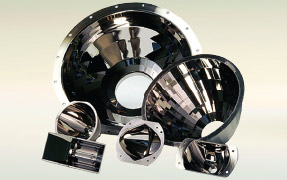Fiber-optic sensors in explosion and detonation experiments
At TNO, considerable effort has been invested into explosion and detonation experiments for energetic materials research. These investigations are required for both the development of new materials and the control optimization of existing materials. Typical measurements include detonation speed, response to high temperature and impact, and shock wave propagation in materials. It is obvious that the measurement systems must be designed with great care to minimize risk. They also need to be protected from the test environment. Furthermore, high-speed measurement is also required to record experimental phenomena. TNO has developed a number of measurement systems based on fiber optic technology. Relative to conventional electrical measurement technology, they offer significant advantages in terms of safety and/or cost.
Fiber optic (FO) sensors are currently generating significant interest for special applications. This is because they basically have no electrical components at the measurement location and can be used without risk of interaction with the explosive materials under investigation. Furthermore, since an optical fiber has a typical diameter of 0.25mm, measurements can also be done at locations that are not accessible to other type of sensors. An example is the measurement of shock waves in explosives using a fiber Bragg grating (FBG). The loss in an optical fiber is generally extremely low. This allows placement of the detection unit and its electronics at a safe distance from the experiment without requiring expensive protection and shielding. These advantages allows these sensors to outperform their conventional electrical counterparts. We now describe some of our FO sensor systems developed for explosion or detonation experiments.
The fiber optic probe (FOP) shown in Figure 1 is designed to detect the shock wave of detonation velocity in explosive materials. It consists of a 1mm-diameter polymer fiber in which several holes are drilled at predetermined distances. It is designed for insertion in the explosive material. Upon detonation, the shock wave travels in the explosive along the FOP. Air confined in the consecutive holes is compressed and ionized as the shock wave propagates, and generates a series of light pulses transmitted by the polymer fiber to a detector. The detonation velocity is then calculated by measuring the time between the pulses.1
Another important measurement is the so-called ‘cook-off’ test, used to investigate the sensitivity and response of an explosive to high temperatures. Typically, a steel cylindrical tube is filled with a given explosive material and heated up to several hundreds degrees by a heating wire. Upon explosion, the change in the cook-off tube diameter is monitored by an optical fiber wound on the tube. The length of this fiber is measured by an interferometer (see Figure 2) and provides information about the reaction process in the tube.2,3
For detonation or shock-wave pressure measurement we use fiber Bragg grating (FBG) sensors. FBGs are short lengths of optical fiber that filter out specific wavelengths in the fiber core. The wavelength of the light reflected by such gratings depends on the grating period and on the strain and/or pressure applied to the fiber. We designed and built different FBG sensor systems to measure shock waves in materials.1,4 Recently, we demonstrated for the first time the application of short FBGs to measure the pressure amplitude of shock waves in explosives.

Our fiber-optic sensors, specifically designed for detonation or shock-wave measurements, are small and they are configured so that the associated detection unit can be placed in a safe location. Future development will be focused on FBG sensor array applications and on improving the performance of our fiber optic Fabry-Perot velocity measurement system, recently developed to measure object velocities from 100 m/s to 20 km/s.5
The authors gratefully acknowledge the Photonic Center of the Hong Kong Polytechnic University for providing short FBGs.
Lun Cheng is a senior research scientist at TNO Science and Technology. His main research interests are interferometric systems, optical sensing, and special fiber-optic sensor systems. He is also involved in several European Space Agency (ESA) proposals and projects within the framework of the infrared space interferometer program (DARWIN) and in structural health monitoring using FBG sensors.
Jan van Bree
Netherlands Organization for Applied Scientific Research
(TNO)
Rijswijk, The Netherlands





